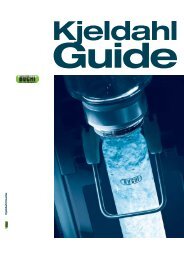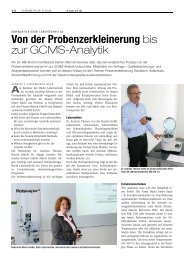The Laboratory Assistant - Buchi
The Laboratory Assistant - Buchi
The Laboratory Assistant - Buchi
You also want an ePaper? Increase the reach of your titles
YUMPU automatically turns print PDFs into web optimized ePapers that Google loves.
2<br />
2.1<br />
2.1.1<br />
Part A <strong>The</strong>oretical basis for distillation 17<br />
<strong>The</strong>oretical basis for distillation<br />
<strong>The</strong>rmodynamic basis<br />
Conditions of state, phase transitions<br />
Depending on pressure and temperature, any material may be present in three<br />
different phases: solid, liquid, and gaseous. In the solid phase the smallest particles<br />
behave as a solid showing only small degrees of motion due to a high<br />
binding energy. <strong>The</strong>y swing in a fixed position in their molecular lattices and usually<br />
rotate around their axes. <strong>The</strong> higher the temperature, the more violently they<br />
swing or rotate and the distance between the particles usually increases. When<br />
heat is applied to a solid material, its kinetic energy increases steadily until, at<br />
the melting point, the kinetic energy becomes strong enough to overcome the<br />
forces of attraction. <strong>The</strong> material liquefies. <strong>The</strong> individual molecules are now able<br />
to move about more or less freely within the substance, but the attracting energy<br />
between them is still too strong for them to separate from the other molecules.<br />
Additional heating of the material removes that energy barrier up to the boiling<br />
point. <strong>The</strong> molecules then have sufficient kinetic energy to enable them to move<br />
freely within space without being held back by the forces of attraction. <strong>The</strong> material<br />
is now a gas.<br />
<strong>The</strong>se phase transitions are reversible. When a gas turns into a liquid, people<br />
talk of condensation. When a liquid turns into a solid, it freezes or solidifies. If<br />
the right conditions are selected, a solid can also be transformed directly into<br />
its gaseous phase, bypassing the liquid state. This process, in either direction,<br />
is called sublimation. <strong>The</strong> existing phase is influenced both by the temperature<br />
and by the pressure. <strong>The</strong> lower the pressure, the weaker the forces of attraction<br />
between the molecules. This means that both the melting point and the boiling<br />
point are lower at low pressures.<br />
A given material may have several solid phases that differ in their crystalline<br />
lattice structure but, with the exception of helium, it can have only one liquid and<br />
one gaseous phase.<br />
Fig. 5 shows the relationships between temperature, pressure, and volume.<br />
This diagram shows various possible paths for going from the solid into the gaseous<br />
phase.<br />
– Path from A to F: A solid is being heated under constant atmospheric pressure.<br />
When it reaches the melting point, there is a sudden increase in volume: the<br />
material liquefies. With further heating, its volume increases steadily until the<br />
Figure 4:<br />
Particle model of the<br />
3 phases: solid, liquid,<br />
and gas.





